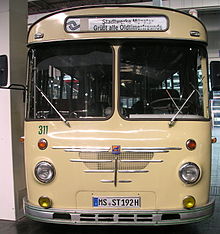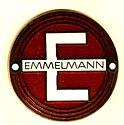Adolf Emmelmann body factory
| Adolf Emmelmann body factory
|
|
|---|---|
| legal form | GmbH |
| founding | 1896 |
| Seat | Hanover-Bothfeld |
| management | Emil, Adolf, Michael, Jens-Michael Emmelmann |
| Branch | Body construction : bus bodies, conversions, special vehicles |
The Adolf Emmelmann body factory was in Hannover -based Coachbuilder mainly through its bodies on Bussing - chassis for buses became known. The company was based on Sutelstrasse in the Bothfeld district .
history
The company was founded at the time of the founding years of the German Empire in 1896 by the wheelwright Emil Emmelmann (born September 4, 1868 in Wollersleben , † October 17, 1935 in Hanover). Initially only carriages were produced , later superstructures for trucks were also produced.
After the First World War and the German hyperinflation in the Weimar Republic , Emmelmann's son Adolf (born December 24, 1899 in Isernhagen ; † November 19, 1986 in Hanover) took over the business in 1928. At the beginning of the 1930s, the founder of what would later become Adolf Emmelmann Betriebs GmbH & Co. KG switched production to bodies for touring buses, which were built on chassis from Büssing , Hansa-Lloyd , Krupp and Daimler-Benz .
During the time of National Socialism and the Second World War , trailers, sleds and the like were produced. After the war and the repair of the bomb damage that the company had suffered during the air raids on Hanover , production and sales slowly increased again.

At the beginning of the 1950s, a close cooperation began with the Büssing company, which then supplied almost all of the chassis for Emmelmann's bodies. In the economic boom , the 1,000th Büssing-Emmelmann bus left the factory as early as 1956 . The products of this cooperation soon achieved success in competitions in Nice and Montreux . Built city buses - as a joint or trolleybus - and intercity buses and coaches . Articulated buses were built from 1955 onwards using chassis with an underfloor engine from Büssing and trailers from Schenk. By the end of 1956, 18-meter-long, four-axle articulated buses were built, from 1957 to 1964 16.5-meter-long, three-axle articulated buses and from 1965 again up to 18-meter-long, three-axle articulated buses.
From 1953 to 1958 the conversion from the chassis construction to the so-called composite construction was carried out. In 1958, Emmelmann introduced a “stepped high-decker” touring coaches, which offered additional space for luggage under the higher-positioned middle and rear sections. From 1961 the (large) Büssing coaches by Emmelmann were completed (Senator or Prefect 15, but also Senator 12 and 14, Consul 11 and Prefect 13). In January 1966, Adolf Emmelmann Karosseriefabrik GmbH increased the share capital to 2.2 million D-Marks , of which Büssing took over and paid in a share of 60,000 DM at nominal value. The design was repeatedly adapted and further developed to reflect contemporary tastes, most recently in 1969 with straight lines and rectangular headlights. After the Büssing-Automobilwerke , which held a 27% stake in the otherwise family-owned capital of the body shop, was taken over by MAN in 1971 , the future initially looked good for the Büssing-Emmelmann buses. But around three years later, in 1974, MAN concentrated its new bus range on the former Büssing location in Salzgitter-Watenstedt . For the body builder Emmelmann, who last worked exclusively for Büssing at the Hanover location, this meant the end in 1975.
2001 joined the studied vehicle manufacturer and later Hanoverian CDU - councilor , Jens-Michael Emmelmann (* 1976 in Hannover), first as authorized , in 2008 then as a managing partner in the Adolf Emmelmann GmbH & Co. KG a, 2008 to present (as of December 2015) also as managing partner of Michael Emmelmann GmbH & Co. KG .
Adolf-Emmelmann-Strasse
In the Hanoverian district of Bothfeld, Adolf-Emmelmann-Straße , which was laid out in 2002 and connects Sutelstraße with Straße Im Heidkampe , honors the entrepreneur who died in 1986. The former company premises were built over with a shopping park in 2003.
gallery
Emmelmann BY-31 , 1960 in Helsinki
Converted Büssing-Emmelmann coach from the 1960s
Büssing-Emmelmann train bus
literature
- Public transport handbook . Association of Public Transport Companies, 1952
- Eckhard Fischer: The Büssing company . Archive of the City of Hanover, 2010
- Klaus Mlynek, Waldemar R. Röhrbein: Stadtlexikon Hannover: From the beginnings to the present . Schlütersche, 2010, ISBN 3-8426-8207-7
Web links
- Patent for omnibus swing doors , accessed December 23, 2015
- Büssing buses with bodies from Adolf Emmelmann Karosseriefabrik GmbH on Drehscheibe-Online.de, accessed on December 23, 2015
- New 10 m coach from Büssing . In: Omnibusrevue , March 1969; accessed on December 23, 2015
Individual evidence
- ↑ a b c d e f g h Waldemar R. Röhrbein : Emmelmann, body factory. In: Klaus Mlynek, Waldemar R. Röhrbein (eds.) U. a .: City Lexicon Hanover . From the beginning to the present. Schlütersche, Hannover 2009, ISBN 978-3-89993-662-9 , pp. 159f .; Digitized in the Google book search
- ↑ a b c d Helmut Zimmermann : Hanover's street names - changes since 2001 . In: Hannoversche Geschichtsblätter , pp. 277–286; here: p. 277
- ^ Jürgen Jacobi: Die Karosseriefabrik GmbH Adolf Emmelmann in Hanover . In: Yearbook Omnibusse 2017 , Podszun-Motorbücher, Brilon 2016, ISBN 978-3-86133-815-4
- ^ Eckhard Fischer: Contributions to City History, Volume 24 . Archive of the City of Hanover 2010
- ↑ Jens-Michael Emmelmann: Career ( Memento from December 23, 2015 in the web archive archive.today )
Coordinates: 52 ° 24 ′ 33.6 " N , 9 ° 47 ′ 59.2" E




